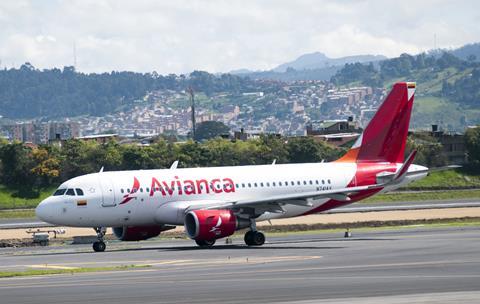[ad_1]
Avianca reported a profit for the third quarter of 2023, as passenger demand remains strong following the demise of two domestic airlines, pushing the company’s results beyond expectations.
The Bogota-based airline turned an $82.1 million profit during the three months ending on 30 September, compared to its $8.1 million loss in the same period last year. Avianca’s third-quarter revenue rose to $1.28 billion from $1.12 billion in the same period a year ago.
“We are very proud of the quarter,” says chief executive Adrian Neuhauser. “These results are based on our new business model, on a cost-driven strategy [and] higher load factors, and not… based on a yield push, and that’s pretty extraordinary for the region.”

The airline’s capacity as measured in available seat kilometres rose 31.5% from the same quarter last year, while its hours flown increased 19.2% year on year.
Its load factor rose to 85.5% from 82.4% one year earlier – higher than Avianca estimated in a business plan – and its average daily aircraft utilisation during the third quarter was “significantly improved”, at 11h 12min, the carrier says. The airline acquired 17 aircraft last quarter, bringing its fleet to 159 aircraft, of which it owns six and leases 153.
Avianca has increased its capacity further in the fourth quarter to fill a hole left by Viva Air and Ultra Air – two domestic carriers that folded earlier this year.
“One of the effects of the restructuring of the market in Colombia, with two airlines failing around us, [is that] there is excess demand that needs to be served by incremental aircraft,” Neuhauser says. Bogota’s El Dorado International airport can now operate at 74 slots hourly, the highest level possible – an increase which has offered Avianca further opportunity.
“To address the missing capacity in the market and to protect those slots from being available to third parties in the future, we had to grow our operations by nearly one quarter into the fourth quarter,” he adds. “By the end of the year we will have 750 flights per day,” up from about 600 in pre-pandemic 2019.
Avianca’s additional flights per month will exceed 4,800, adds deputy chief executive Frederico Pedreira. The airline added those flights to its schedule starting in November, meaning it spent much of the third quarter preparing. “There was, as you can imagine, a lot of work put in, in terms of hiring and training the personnel for this growth,” Pedreira says.
The company added 177 pilots, 334 flight attendants and more than 500 ground handling and airport agents to support the surge.
“The vast majority of what we have added is replacing supply in Colombia,” Neuhauser adds.
Avianca expects to transport 3.4 million passengers in the final quarter of the year, up 31% from the end of the third quarter.
“We are putting back in the capacity that had left the market, for which there is strong demand,” adds chief financial officer Rohit Philip. “We do not expect a long lead time for these markets to be positive from a margin perspective. There is demand for this capacity that should show up in our numbers relatively quickly.”
Avianca expects “continued out-performance versus [its] business plan” in the coming months.
The carrier’s third-quarter cargo revenue decreased 28.1% relative to last year, to $138 million from $192 million, due to market softening, Avianca says, though the figure still exceeds its projections. The airline has recently been carrying more cargo in the bellies of its passenger jets, while its operation of all-cargo aircraft has declined, it adds.
[ad_2]
Source link
